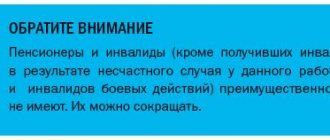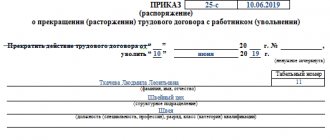Reduction of staff or number of employees is one of the few cases of the Labor Code of the Russian Federation, Article 81, in which an employer can terminate an employment contract with employees on his own initiative. This means one of two events:
- The number of staff units per position is reduced. For example, a store had three salespeople, but two are enough to operate, so one unit needs to be cut.
- Certain positions are excluded from the staffing table completely. Sometimes we are talking about the liquidation of entire structural divisions. For example, a company decided that they did not need a PR department; this work could be outsourced.
At the same time, it is important to arrange everything correctly in order to avoid problems and lawsuits. Let's figure out how to do this.
Common mistakes
If we talk about typical mistakes when abbreviating, these include:
- absence (non-delivery) of notice of reduction;
- dismissal of an employee before the two-month notice period;
- failure to notify employment authorities and the trade union (if any) within the established time limits;
- failure to offer vacancies when available.
When it comes to reducing the number of employees, a fairly common mistake is failure to conduct or incorrect assessment of the preemptive right (Article 179 of the Labor Code of the Russian Federation). For example, employers often have no criteria for assessing labor productivity and qualifications at all, or these criteria are recognized by the courts as subjective.
Features of the procedure and main mistakes in carrying out reduction
Reducing the number of employees is a way to optimize the organization’s activities and a tool for reducing costs. The procedure is provided for by law and is carried out through personnel reduction (clause 2, part 1, article 81 of the Labor Code). Organizations make mistakes at every stage - from the lack of information by the employee about upcoming changes to ignorance of what documents should be issued to the employee upon layoff, what certificates to provide at the request of the employment authorities and when.
Who can't be laid off?
Art. 261 of the Labor Code of the Russian Federation establishes categories of persons who are not subject to reduction. These include:
- pregnant woman;
- a woman with a child under 3 years of age;
- a single mother raising a disabled child under the age of 18;
- a single mother raising a child under 14 years of age;
- another person raising the above children without a mother;
- a parent (other legal representative of the child) who is the sole breadwinner of a disabled child under the age of 18 or the sole breadwinner of a child under 3 years of age in a family raising three or more young children, unless the other parent (other legal representative of the child) is in an employment relationship.
For more information about the categories of persons who cannot be laid off, read the article “6 situations when laying off an employee can result in a lawsuit.”
To whom compensation is not paid?
In Article 349.3 of the Labor Code of the Russian Federation, the legislator established a restriction on the provision of severance pay for managers, their deputies, chief accountants, as well as members of executive bodies:
- state corporations;
- organizations in whose authorized capital the share of participation of the Russian Federation is more than 50% of state extra-budgetary funds;
- state and municipal institutions.
However, if the payment of compensation is provided for in an employment or collective agreement, then it is still paid, but in a limited amount - no more than three average monthly salaries.
How and why to prove the fact of reduction
The burden of proving the fact of layoff lies with the employer. The launch of the reduction procedure begins with a decision by the authorized person of the company to carry out the reduction.
Such a decision must be made in writing. This could be, for example, an order from the general director or a protocol of the board of directors. Based on this decision, an order is issued to change the staffing table and the staffing table is directly changed. It is these documents that will serve as proof of the reduction.
In addition, since labor disputes most often arise after dismissal due to a reduction in the number or staff of employees, the court also examines whether a new employee was hired for the same position after the dismissal. In this case, the reduction may be considered illegal (“imaginary”). From this we can conclude that the fact of a reduction can be proven by the absence of a position in the staffing table in effect at the time of consideration of the dispute.
Responsibility for non-compliance with the procedure
Organizations make mistakes at every stage - the employer offers lower-paid work when reducing staff or voluntarily resigning. This does not reduce, but increases costs - the employer faces real liability for violations of the law.
The court reinstates the employee - the employer pays, by court decision, the average salary for the entire period of forced absence (Article 394 of the Labor Code), and sometimes compensates for moral damage (Article 237 of the Labor Code). The employer will be required to pay all legal costs (Article 88 of the Code of Civil Procedure).
If the dismissed person applies for protection to the labor inspectorate and the termination of the contract is recognized as incorrect, the employer faces administrative liability under Art. 5.27 Code of Administrative Offences.
Why is a redundancy commission needed?
Legislatively, the employer has no obligation to create a redundancy commission, but from a practical point of view, its necessity is beyond doubt.
First of all, it is needed to determine the categories of employees who are not subject to layoffs. In addition, the work of this commission is useful in assessing the preemptive right. The staff reduction commission reviews the information provided for each candidate for dismissal. The decision made regarding employees who are not subject to layoffs and have a preferential right to remain at work is documented in writing - a protocol, a decision, etc.
The commission is created by order of an authorized person. The commission, as a rule, includes personnel specialists, one or two employees who are members of a trade union (if the company has one), and lawyers.
Complete the necessary documents
Before dismissal, you need to prepare for each employee:
- A certificate of the amount of earnings for two calendar years in form 182n.
- Documents with information that were sent to the Pension Fund during its work in the SZV-M form and in the SZV-STAZh form.
- A copy of section 3 of the calculation of insurance premiums.
It is also necessary to make an entry in the personal card form T‑2. Indicate the basis for dismissal - staff reduction, date, as well as the number and date of the order to terminate the employment contract. The document is signed by the employee and the HR department employee.
Finally, all that remains is to draw up a settlement note in form T-61. It contains general information about the employee, information about termination of the employment contract and the amount of the due payment. The employer has no obligation to show this document to the employee.
Seasonal workers and conscripts
The legislation provides for specifics in the procedure for laying off seasonal workers and workers who have entered into a fixed-term employment contract of up to 2 months. Please note that for other employees with whom a fixed-term employment contract has been concluded for other reasons, the reduction procedure is similar to that provided for employees with whom an employment contract has been concluded for an indefinite period.
The specifics of laying off seasonal workers and workers with whom a fixed-term employment contract of up to 2 months has been concluded relate to the timing of delivery of notice and payment of benefits.
Thus, an employee engaged in seasonal work must be notified of his upcoming dismissal due to a reduction in the number or staff of the organization’s employees at least 7 calendar days in advance.
Accounting and tax accounting, employee settlements, reporting to the Federal Tax Service, Pension Fund of the Russian Federation, Social Insurance Fund and Rosstat, currency accounting - all in one service.
To learn more
For employees who have entered into an employment contract for a period of up to 2 months, the period is even shorter - they must be notified of the upcoming layoff at least 3 calendar days in advance.
As for the payment of severance pay to these categories of employees upon dismissal under clause 2, part 1, art. 81 of the Labor Code of the Russian Federation, then for seasonal workers the amount of benefits is equal to the amount of two-week average earnings. And employees who have entered into an employment contract for a period of up to two months are not paid severance pay upon dismissal as a general rule, unless otherwise established by federal laws, a collective agreement or an employment contract.
Layoff or other job
Before laying off an employee, the employer is obliged to offer him other positions according to his qualifications, if they exist and are vacant. They must be offered right up to dismissal. The list of proposals should be indicated in the notice given 2 months in advance. If the employee agrees, a transfer will follow instead of a layoff. If there are no suitable positions or the employee’s consent, the dismissal will continue as usual.
The union is aware
The trade union (if it operates in the organization) must be notified of the upcoming layoff within the same 2 months as the employees. If you plan to dismiss more than 15 people, the period will increase to 3 months. With such large-scale reductions, the Employment Service must also be warned.
Dismissal of an employee upon change of ownership
First of all, it is worth noting that a change of owner does not automatically terminate the employment contract with existing employees.
The categories of employees with whom the employment contract can be terminated and the periods during which dismissal can be effected are limited. To employees with whom employment relations can be terminated on the basis provided for in clause 4, part 1, art. 81 of the Labor Code of the Russian Federation (change of owner of the organization’s property), includes the head of the organization, his deputies and the chief accountant.
The period during which the new owner has the right to terminate the employment contract with the above-mentioned persons in connection with a change in the owner of the organization’s property must be no later than 3 months from the date his ownership rights arise.
A change in the owner of the organization’s property is not grounds for terminating employment contracts with other employees of the organization.
If the new owner decides to carry out a reduction, then starting this procedure is allowed only after state registration of the transfer of ownership.
Guarantees and compensation
When an employment contract is terminated due to a reduction in the number or staff of the organization's employees, the dismissed employee is paid a severance pay in the amount of average monthly earnings. He also retains his average monthly salary for the period of employment, but not more than 2 months from the date of dismissal (including severance pay).
In exceptional cases, the average monthly salary will be retained by the employee for the third month from the date of dismissal by decision of the employment service body, provided that within two weeks after dismissal the employee applied to this body and was not employed by it.
It is worth noting that Art. 178 of the Labor Code of the Russian Federation establishes minimum guarantees. Thus, an employment contract or collective agreement may establish an increased amount of severance pay, with the exception of cases expressly provided for by law.
One cannot fail to say something about the “northern” workers. They retain their average monthly earnings for the period of employment, but not more than 3 months from the date of dismissal, including severance pay.
In exceptional cases, the average monthly salary is retained for the specified employees during the 4th, 5th and 6th months from the date of dismissal by decision of the employment service body, provided that within a month after dismissal the employee applied to this body and was not they are employed.
The procedure for calculating average earnings is established by Decree of the Government of the Russian Federation dated December 24, 2007 No. 922.
Notify the employment office of layoffs
You must report layoffs to the department no later than the Law of the Russian Federation of April 19, 1991 N 1032-1, no later than two months before the termination of employment contracts (three months if there are massive layoffs), if you are acting on behalf of the organization, or no less than two weeks, if you are an individual entrepreneur. You must send a notification to the employment service in which you indicate the following information about the layoffs:
- job title;
- profession;
- specialty and qualification requirements for it;
- terms of remuneration.
The notification must be accompanied by the same package of additional documents that you sent to the trade union.
Employment service notification template about staff reduction →
Advantages and disadvantages
Of course, layoffs are not a pleasant thing for an employee, especially during a crisis in the labor market. But still, a reduction, in contrast to voluntary dismissal, has a plus - it is severance pay, paid in the amount of average monthly earnings and retained by the employee for at least two months.
For the employer, the advantages are obvious - his initiative, that is, the employee cannot refuse, further optimization of expenses and reduction of the fund for wages. However, such a procedure will only further reduce the fund, since the reduction procedure itself is expensive.
Calculation example
Ivanov I.I. worked as a manager for two years and was dismissed due to staff reduction on 01/01/2018. On January 10, he contacted the employment center and was registered, but could not find a job until 04/01/2018, that is, until that moment he retained his unemployed status. Ivanov I.I.’s work schedule was standard with a 5-day work week. Initial data: for 2021 Ivanov I.I. he worked 247 days, 28 calendar days and 19 working days he was on vacation: from 08/01/2017 to 08/28/2017. The salary of Ivanova I.I. was unchanged for the entire 2021 and amounted to 30,000 per month.
Formula for calculating severance pay by Ivanova I. upon dismissal due to staff reduction:
- actual shifts worked: 247 - 19 = 228;
- average salary per day: 331,428.57 / 228 =1453.63;
- amount for January: 1453.63 × 17 = 24,711.71;
- February amount: 26,165.34;
- amount for March: 31,979.86.
Ivanov would be entitled to benefits for the first month, that is, payment of compensation for January, even if he was employed. But benefits for February and March, if you start a new job during these months, would be calculated in proportion to the days of unemployment.
Mass layoff
In order for an employer to understand whether he has a mass layoff, he should refer to industry and (or) territorial agreements. Part 1 of Art. speaks about this. 82 Labor Code of the Russian Federation.
So, for example, in Moscow, according to the Moscow tripartite agreement for 2016-2018 between the Moscow Government, Moscow trade union associations and Moscow employers' associations, the criteria for mass dismissal are considered to be the indicators of the number of dismissed employees of organizations registered in the city of Moscow, with a workforce of 15 or more people for a certain period of time:
- dismissal within 30 calendar days of more than 25% of the total number of employees;
- dismissal of employees in connection with the liquidation of an organization of any organizational and legal form;
- reduction in the number or staff of the organization's employees in the amount of:
- 0 or more people within 30 calendar days;
- 200 or more people within 60 calendar days;
- 500 or more people within 90 calendar days.
Notify the union
If there is such an organization, you need to inform it about upcoming layoffs Article 82 of the Labor Code of the Russian Federation no later than two months before them. Or three months, if the reductions are massive Resolution of the Council of Ministers - Government of the Russian Federation of February 5, 1993 No. 99. They are considered as such if they liquidate an organization with at least 15 employees, or dismiss 50 people in a month, 200 in two, or 500 in three.
The trade union must be provided with the personal data of workers, their profession, position and specialty. You need to add to the package of documents:
- a copy of the order to reduce staff or numbers;
- draft order on dismissal of employees;
- draft staffing table.
Template for union notice of staff reduction →








